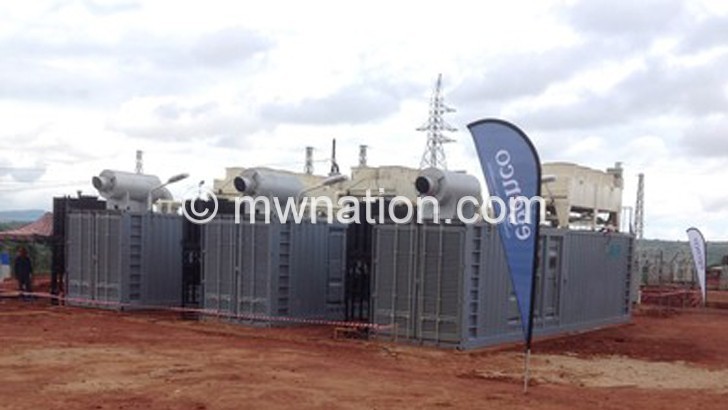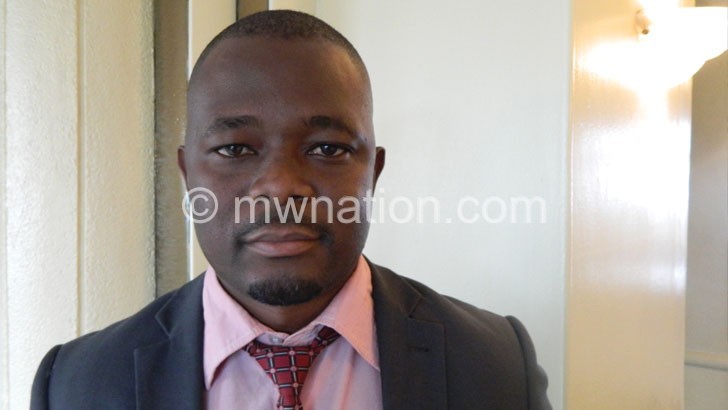Egenco blowing K3bn on gensets
- As water flow in Shire down by 57 percent
- Burden pushed to consumers—energy analyst
The Electricity Generation Company (Egenco) is spending over K3 billion per month to buy fuel for its diesel-powered generators to shore up available power amid low water levels in the Shire River.
Egenco spokesperson Moses Gwaza confirmed, in an interview this week, that all its generators were running to complement hydropower generation following reduced water flows in Shire River where the company’s major power stations are installed.

He explained on Tuesday that the diesel generators were producing 20 megawatts (MW) at Mapanga (Blantyre), 10 MW at Kanengo I, 10 MW at Kanengo II, Lilongwe A 4.9 MW (Lilongwe) and 6 MW at Luwinga in Mzuzu.
Information on Egenco website indicates that the company has 25 diesel power plants in Blantyre, Lilongwe and Mzuzu, which cumulatively produce 50.9 MW.

These generators, Egenco says, run to meet demand during peak periods, when there is limited generation capacity in the hydropower stations.
Peak periods are usually between 5.30am and 8.30am, 11.30am and 1.30pm and 5.30pm and 9pm.
This means each generator runs for a minimum of nine hours a day.
Gwaza did not respond to our question on how much the company spends monthly on the diesel it uses to run the gensets. But, last year, when Egenco chief executive officer William Liabunya toured the generators’ site in Mzuzu, said each generator was consuming at least 560 litres per hour.
Based on this, Weekend Nation’s calculations indicate that the 25 generators are consuming 14 000 litres per hour, translating to 126 000 litres per day, if the machines operate for a minimum of nine hours daily, as per Egenco announcement. Initially, the generators were running for at least 16 hours a day.
Sources say Egenco buys the diesel at wholesale price of K802.79 per litre, meaning the company spends roughly K101 151 540 per day—about K3.1 billion monthly.
In December last year, Principal Secretary for Natural Resources, Energy and Mining Patrick Matanda confessed, when he appeared before the Parliamentary Committee of Government Assurances, that running costs of the generators were high and unsustainable.
Catholic University of Malawi economist Gilbert Kachamba said using generators is costly and unsustainable for the country’s economy.
He said Egenco should be seeking cost-effective electricity generation and a long-term solution to the electricity challenges in the country.
“Otherwise, operating the generators will not help us because they are unsustainable and an expensive venture for the country. When we were getting these machines, my understanding was they were a short-term solution towards our problems, but running them for long-term is a non-starter,” said Kachamba.
Electricity Supply Corporation of Malawi (Escom) also leased 84 diesel-powered generators from Aggreko in Dubai for two years (January 2017 to December 2019). The gensets added 78MW to the national grid.
However, use of the gensets resulted in a 24.67 percent increase in electricity tariffs.
Energy and mining expert Grain Malunga also observed that running a poor country like Malawi on generators was not sustainable and as such consumers will continue paying for the huge operating costs.
“They [consumers] will continue to become poorer… Manufacturing industries’ performance will also go down and government revenue (tax) will reduce. Security risk will also increase due to increased darkness,” said Malunga, a former minister of Mines and Energy.
On Wednesday, Gwaza said the power utility’s greatest challenge was the reduced water flows in Shire River, which meant reduced generation capacity.
“As of today [Tuesday], the Shire River water flow at Kamuzu Barrage as at 5am was 150.68 m3/s [cubic metres per second] against the required 260 m3/s for us to run all the machines [at Nkula, Tedzani and Kapichira hydropower stations],” said Gwaza.
This has resulted in the company generating an average of 250 MW (including from diesel generators) instead of a combined output of about 351 MW, according to Gwaza.
In February this year, Malawians enjoyed continuous supply of electricity following the rise in water levels in the Shire.
“Despite the dwindling water levels, together with our partners such as Escom and others, we should be able to continue maintaining improved generation capacity using the diesel generators and other interventions,” Gwaza said.
In the 2019/20 National Budget, which Finance minister Joseph Mwanamvekha presented in Parliament on Monday, government has allocated K40 billion to the energy and mining sector, part of which the minister said would support Egenco in its power generation programme and to diversify energy.
“Government will fund Egenco for a new coal-fired power plant, to be implemented in phases using our own resources… Government will also support Egenco to borrow domestically either using a long term bond or through PPP [public private partnership] arrangement in order to tap into pension funds,” he said.
In February, Egenco switched off its generators due to increased hydro electricity generation resulting from heavy rains the country experienced.
Egenco recently developed a 15-year strategic plan, which Gwaza said was a roadmap to address the power challenges the country was facing.
“The strategic plan is in tandem with the National Energy Policy of 2016 and the Integrated Resource Plan 2017. The plan has both short and long-term solutions to address the challenges.
“In a nutshell, there are a lot of projects that are under implementation and others that will soon start to end the power shortages,” he said.
In September last year, Escom signed three Power Purchase Agreements (PPAs) with two Independent Power Producers (IPPs), a move expected to add 86 MW to the national grid by December this year.
Malawi Energy Regulatory Authority (Mera) three months ago threatened to revoke the licences for the IPPs that fail to roll out during their specified period.
Mera chief executive officer Collins Magalasi was quoted in The Nation of May 22 2019, as saying failure to roll out could either prolong reliance on diesel-powered electricity or affect government policy of getting rid of blackouts by 2020.
One of the IPPs, Canada-based JCM Matswani Solar Limited, which signed an agreement with Escom and is expected to produce 60MW out of the 86MW, missed its June 2019 deadline. Its country director Phylip Leferink attributed the miss to the water logged land where the plants were to be planted.





